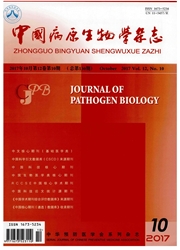

 中文摘要:
中文摘要:
目的利用原核表达系统制备2型猪链球菌细胞分裂起始因子DivIVA重组蛋白并进行纯化,为研究其在调控细胞分裂中的作用奠定基础。方法以2型猪链球菌05ZYH33全基因组为模板,PCR扩增divIVA基因片段,经BamHⅠ和XholⅠ双酶切后将目的片段连接至表达载体pET28a,构建重组表达质粒pET28a-divIVA,经测序鉴定后将重组质粒转化进入表达菌E.coli BL21,以终浓度为0.1mmol/L的IPTG于37℃培养4h,诱导DivIVA蛋白表达。用Ni离子亲和层析柱分离纯化目的蛋白,SDS-PAGE和Western blot进行检测和验证。结果成功构建重组表达质粒pET28a-divIVA,并在E.coli BL21中表达主要以包涵体形式存在的DivIVA蛋白。包涵体蛋白经8mol/L脲变性溶解后经Ni离子亲和层析柱纯化,获得的目的蛋白经SDS-PAGE检测分子质量为36ku,与预期大小相符;经Western blot检测,该蛋白能被相应抗体特异性识别。结论在E.coli BL21中成功表达并纯化了DivIVA蛋白,为研究该蛋白在2型猪链球菌的细胞分裂机制奠定了基础。
 英文摘要:
英文摘要:
Objective To express the cell division protein DivlVA from Streptococcus suis serotype 2. Methods Bioinformatics was used to analyze the divlVA gene in the genome of the Chinese 05ZYH33 strain of S. suis 2. Primers for divIVA were designed using the software Primer5. 0 and the target DNA fragment was amplified with PCR using 05ZYH33 as a template. After the divfVA gene was cloned into a pET28a vector and its inclusion was verified, doubled digestion with BamH I and Xhol I was used to generate a pET28a-divlVA recombinant vector. The recombinant vector was then transformed into E. coli BL21 for over-expression. When E. coli BL21 cells containing pET28a-divIVA were grown to log phase, expression of the target gene was induced with isopropyl-beta-d-thiogalactopyranoside (IPTG) at 37? C for 4 h and cells were then harvested by sonication and the lysate was centrifuged to remove soluble supernatant. The pellet was re-suspended and then filtered through a 0.22-urn pore-size filter. The resulting protein was purified with His- Resin. Results Bioinformatics was used to identify the 05SSU0487 gene coding for DivIVA. A divIVA fragment 687 bp in length was amplified from the genome of 05ZYH33 and was subsequently subcloned into a pET28a expression vector after double digestion with BamH I and Xhol I. The recombinant vector pET28a-divIVA was transformed into E. coli BL21 for over-expression of the target gene via induction with IPTG at 37? C for 4 h. SDS-PAGE revealed a 36-ku protein. Conclusion The DivIVA protein was successfully expressed. This work has provided a basis for the study of the mechanism by which DivIVA regulates cell division.
 同期刊论文项目
同期刊论文项目
 同项目期刊论文
同项目期刊论文
 Rapid visual detection of highly pathogenic Streptococcus suis serotype 2 isolates by use of loop-me
Rapid visual detection of highly pathogenic Streptococcus suis serotype 2 isolates by use of loop-me The beta-galactosidase (BgaC) of the zoonotic pathogen Streptococcus suis is a surface protein witho
The beta-galactosidase (BgaC) of the zoonotic pathogen Streptococcus suis is a surface protein witho Rapid and Sensitive Detection of H7N9 Avian Influenza Virus by Use of Reverse Transcription-Loop-Med
Rapid and Sensitive Detection of H7N9 Avian Influenza Virus by Use of Reverse Transcription-Loop-Med Prevalent distribution and conservation of Streptococcus suis Lmb protein and its protective capacit
Prevalent distribution and conservation of Streptococcus suis Lmb protein and its protective capacit 期刊信息
期刊信息
